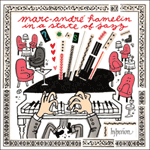
Welcome to Hyperion Records, a British classical label devoted to presenting high-quality recordings of music of all styles and from all periods from the twelfth century to the twenty-first.
Hyperion offers both CDs, and downloads in a number of formats. The site is also available in several languages.
Please use the dropdown buttons to set your preferred options, or use the checkbox to accept the defaults.

| Marc-André Hamelin (piano)» More |
It is best to leave the listener to discover the many surprises contained in this exuberant work—as well as the various apparent influences—though a couple of features are worth pointing out. The brilliant and overwhelmingly energetic first movement is curiously but very effectively rounded out by a reflective and rather lengthy coda, in great contrast to the ebullience of what came before. And the last movement is unique in its rhythmic framework; it is a perpetual motion set in a repeated pattern of 8+7+8+5 beats, and keeps to this stilted sequence up to the very last bar, resulting in many unexpected accents. Incidentally, this movement is usually thought to have been inspired by the pianism of Art Tatum, but this is because it is often performed too quickly. Kapustin’s stated influence here is the world of country music.
from notes by Marc-André Hamelin © 2008
Mieux vaut laisser l’auditeur découvrir les nombreuses surprises et les diverses influences apparentes qui émaillent cette œuvre exubérante. Deux caractéristiques valent cependant d’être soulignées. Le premier mouvement brillant, énergique en diable, est curieusement, mais efficacement complété par une assez longue coda méditative, en fort contraste avec le bouillonnement qui précède. Le dernier mouvement, lui, a une trame rythmique unique: c’est un mouvement perpétuel sis dans un schéma répété de 8+7+8+5 temps, une séquence guindée, conservée jusqu’à la toute dernière mesure et source de nombreux accents inattendus. Pour la petite histoire, on considère généralement que ce mouvement a été inspiré par le pianisme d’Art Tatum, mais c’est juste parce qu’il est souvent joué trop vite. Ici, l’influence déclarée de Kapustin est l’univers de la musique country.
extrait des notes rédigées par Marc-André Hamelin © 2008
Français: Hypérion
Am besten überlässt man es dem Hörer, die vielen Überraschungsmomente, die dieses schwungvolle Werk enthält, zu entdecken, ebenso die verschiedenen ins Auge fallenden Einflüsse. Trotzdem verdienen einige Besonderheiten Erwähnung. Der brillante und überwältigend dynamische erste Satz wird in ungewöhnlicher Weise, aber sehr wirkungsvoll von einer nachdenklichen und ziemlich ausgedehnten Coda abgerundet, die in großem Kontrast zum Überschwang des Vorhergehenden steht. Der letzte Satz ist einmalig in seinem rhythmischen Grundgerüst: es ist ein Perpetuum mobile mit dem sich wiederholenden Taktschema 8+7+8+5, das diese etwas gekünstelte Sequenz bis zum allerletzten Takt beibehält und das zu vielen unerwarteten Akzenten führt. Übrigens glaubt man allgemein, dass dieser Satz durch die Pianistik Art Tatums angeregt worden sei, vielleicht deshalb, weil die Sonate oft zu schnell gespielt wird. Kapustin war hier nach eigener Aussage von der Country-Musik beeinflusst.
aus dem Begleittext von Marc-André Hamelin © 2008
Deutsch: Ludwig Madlener
 Marc-André Hamelin in a state of jazz Marc-André Hamelin in a state of jazzThe brilliant Marc-André Hamelin turns his attention to the music of Kapustin, Antheil, Gulda and Weissenberg—all composers who felt keenly that there was a fundamental desire on the part of the concert-going public to hear something different. Th ...» More |

